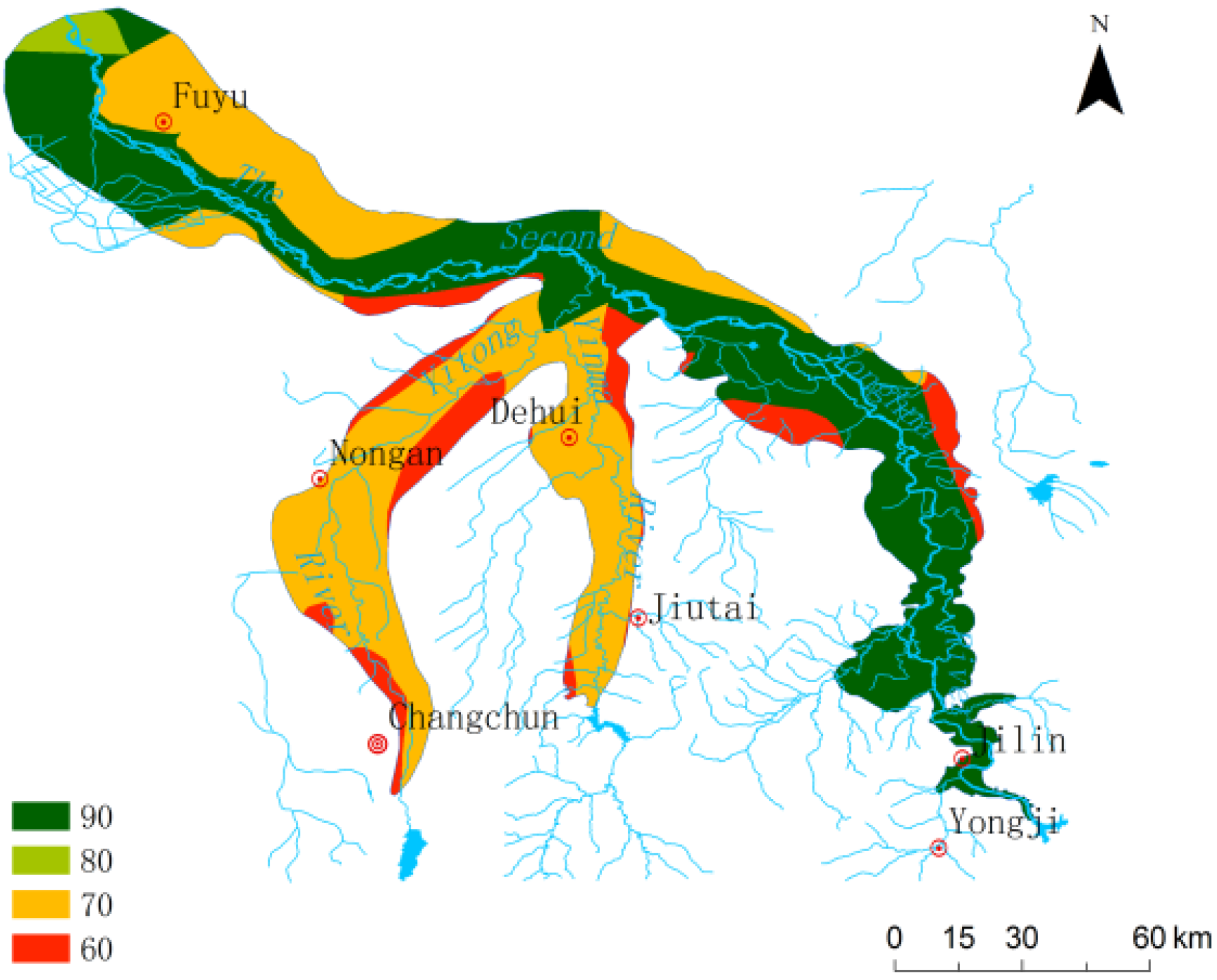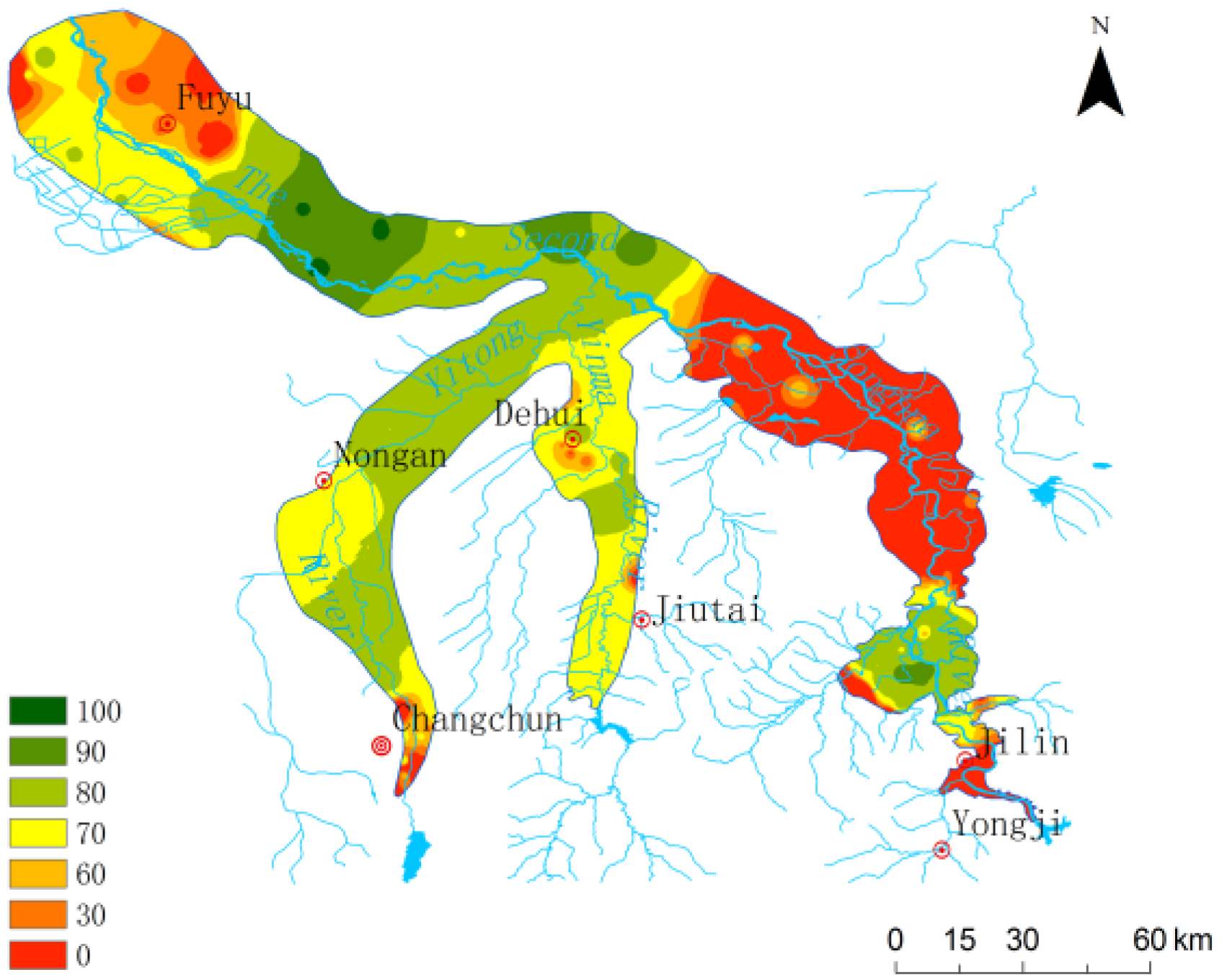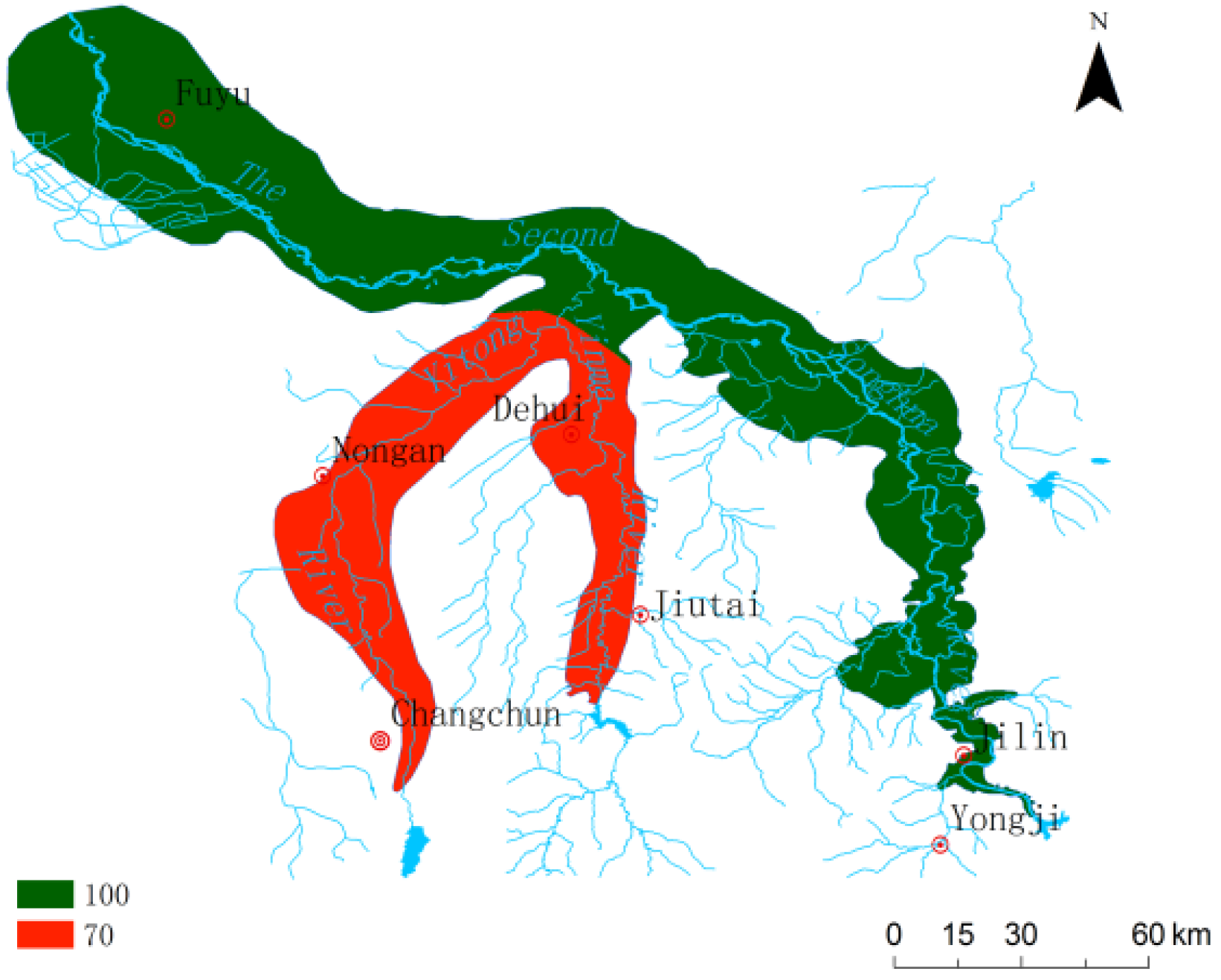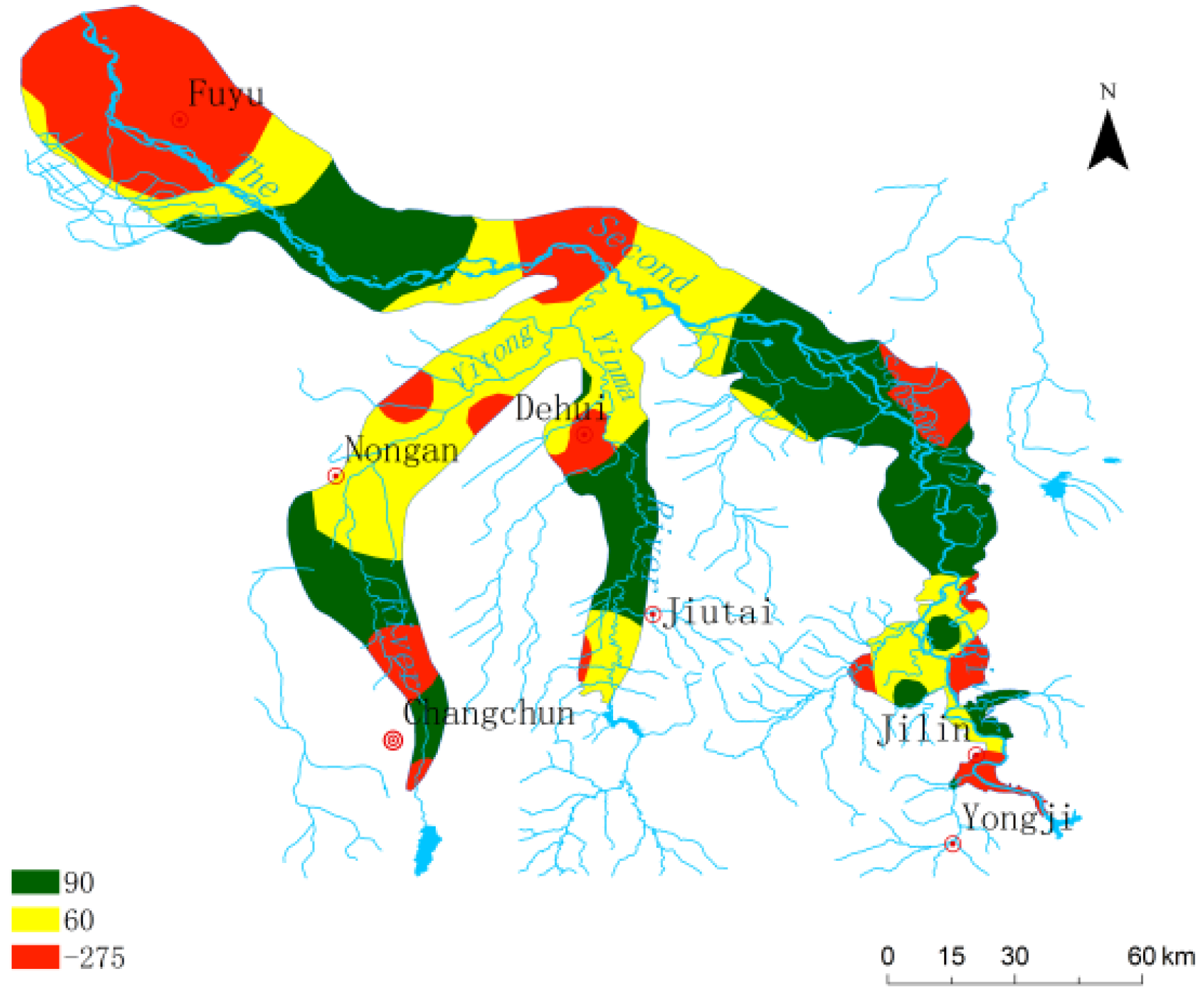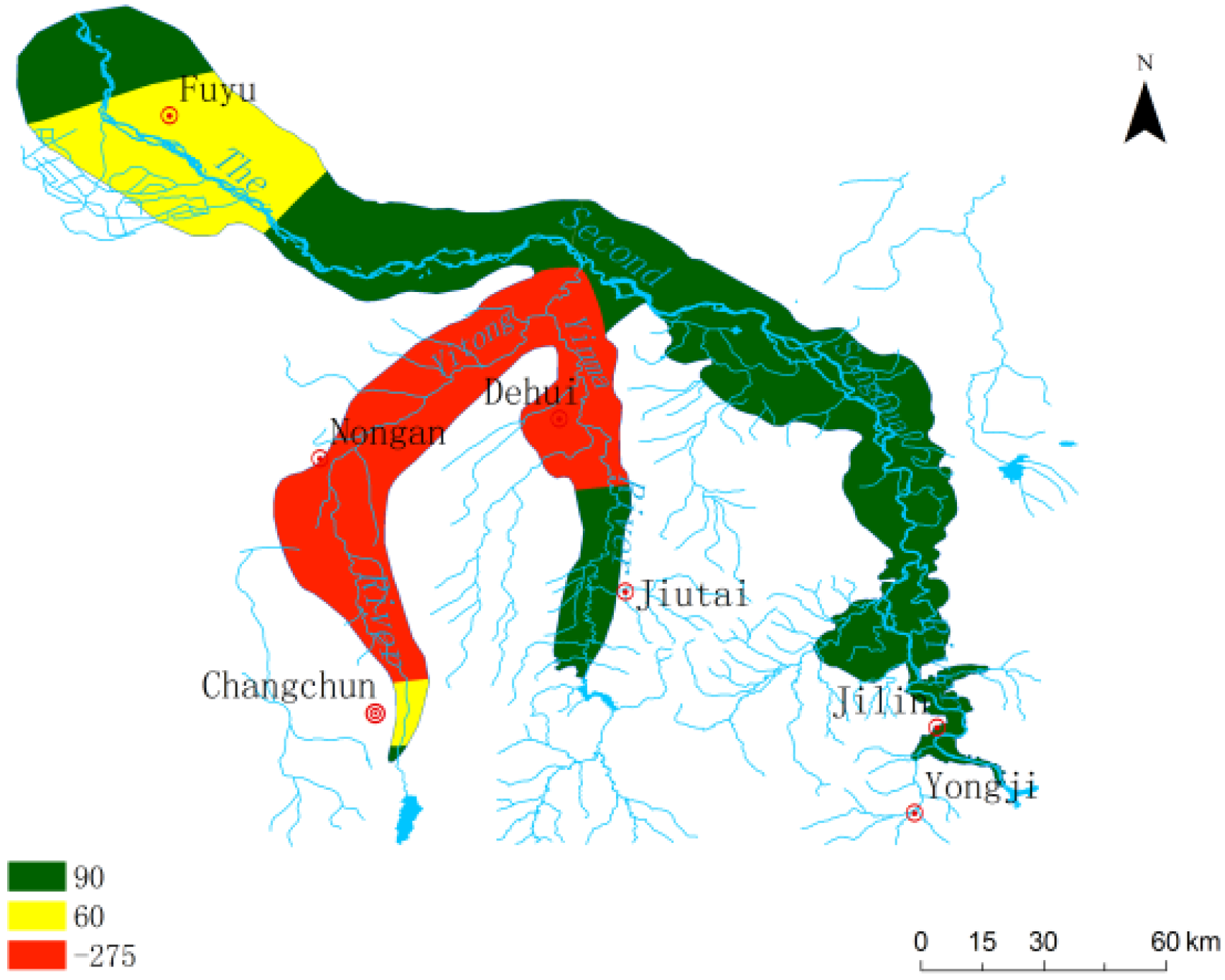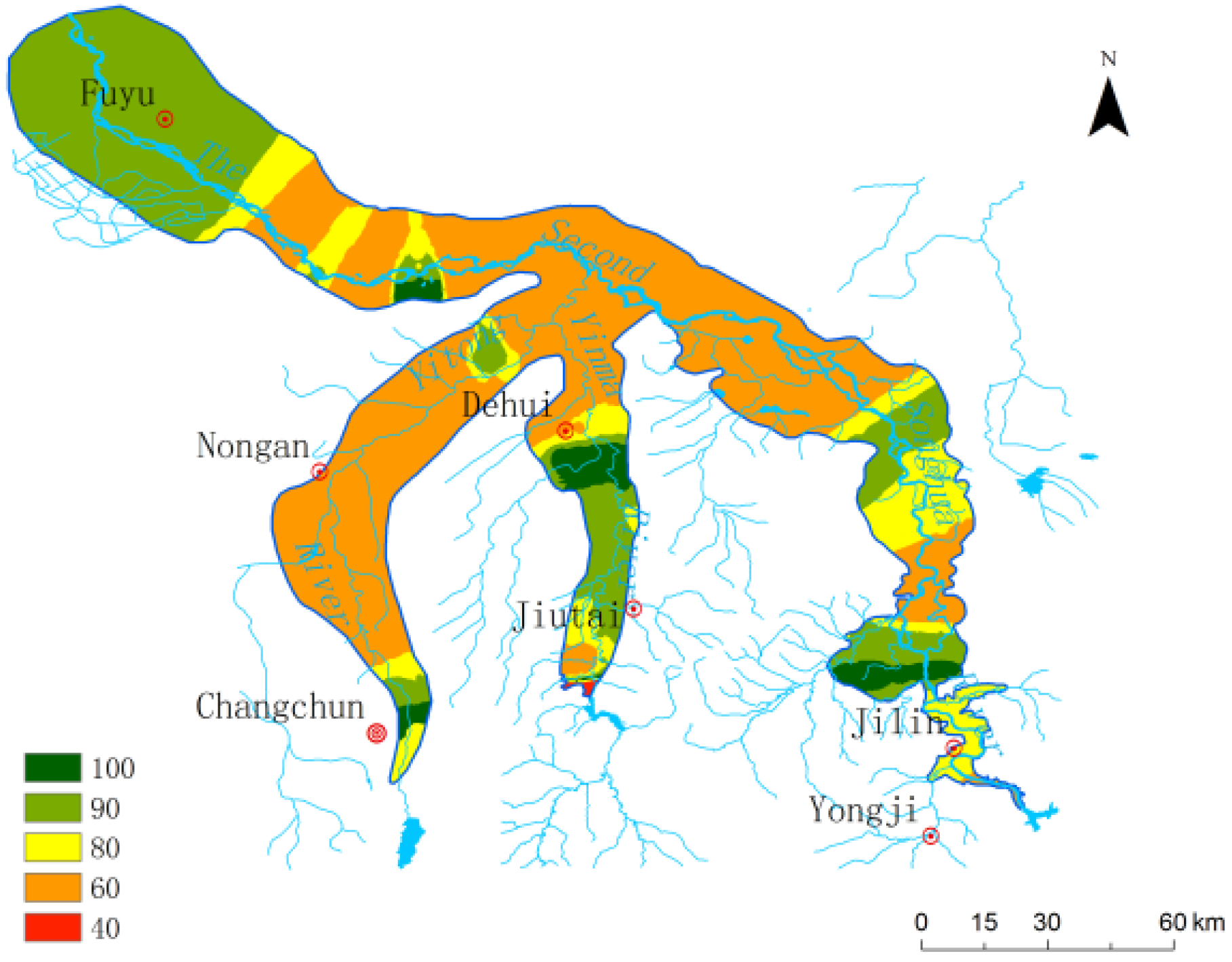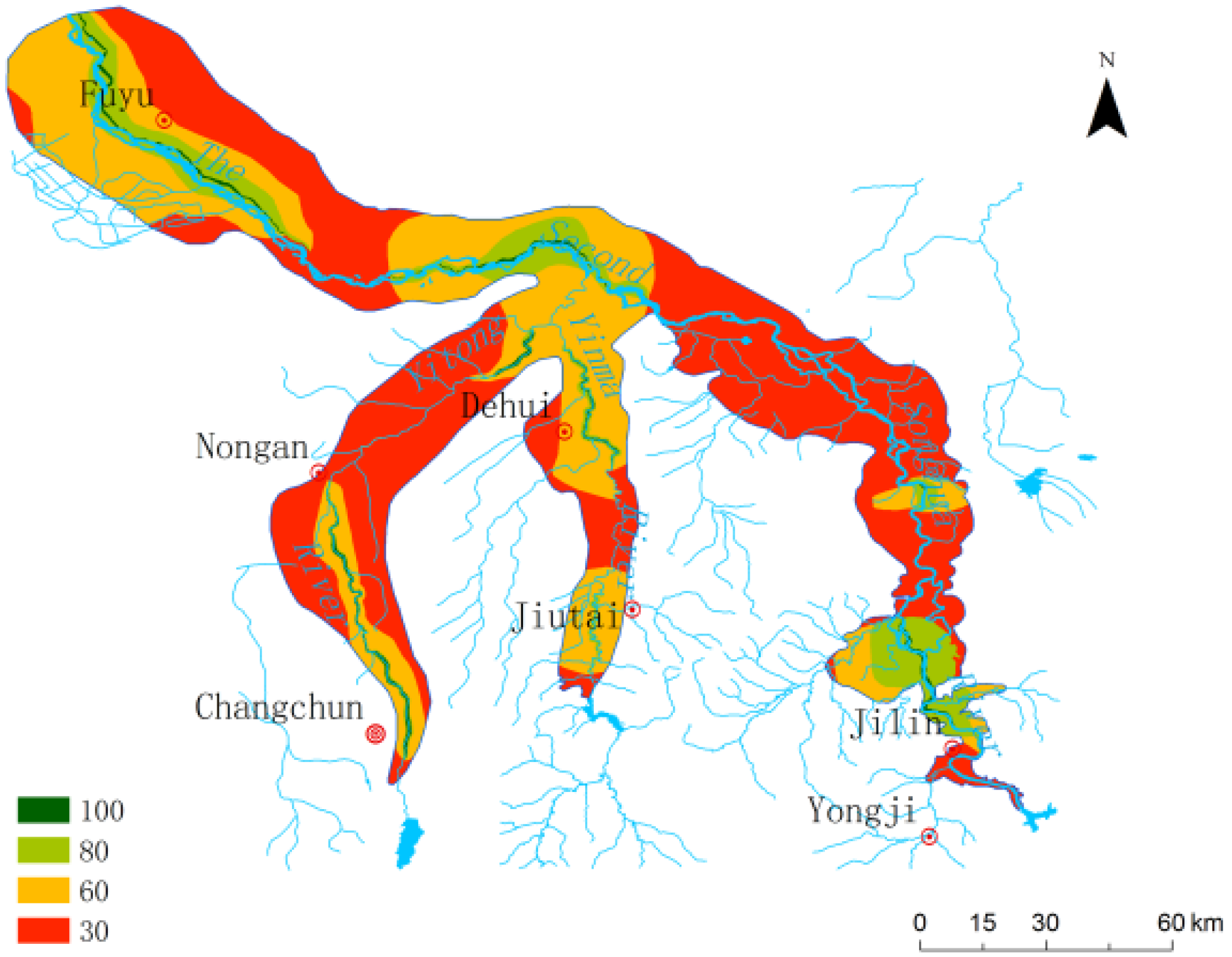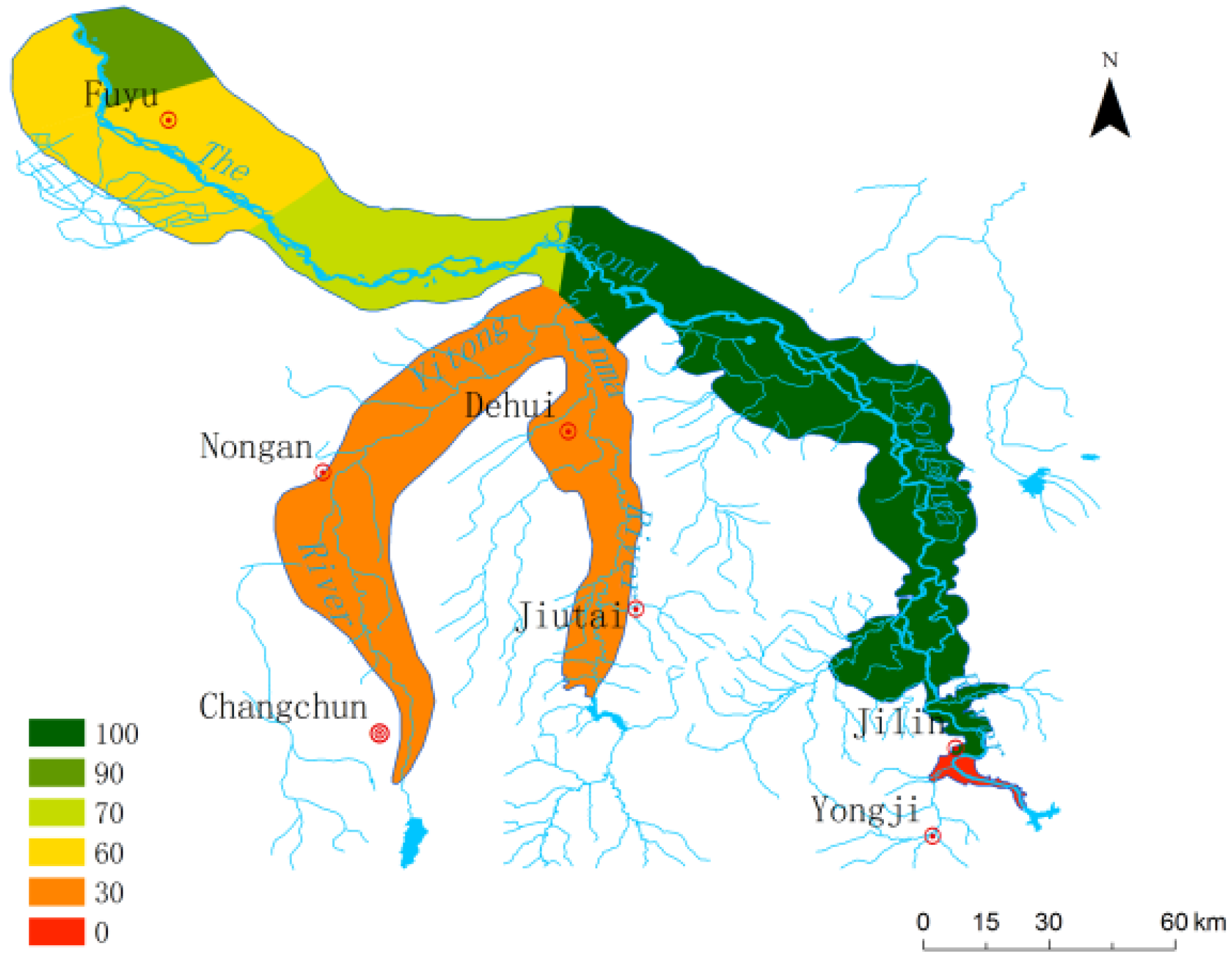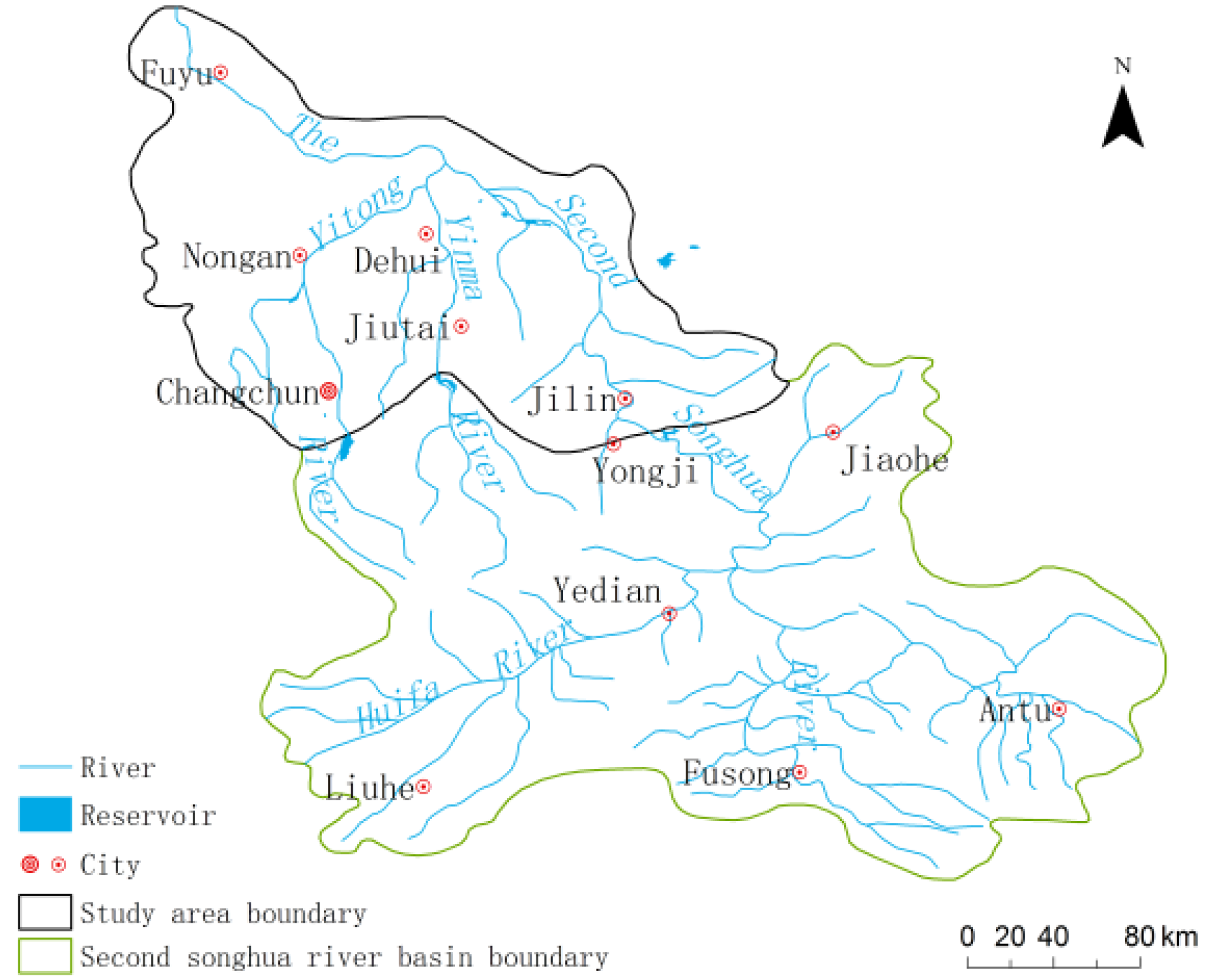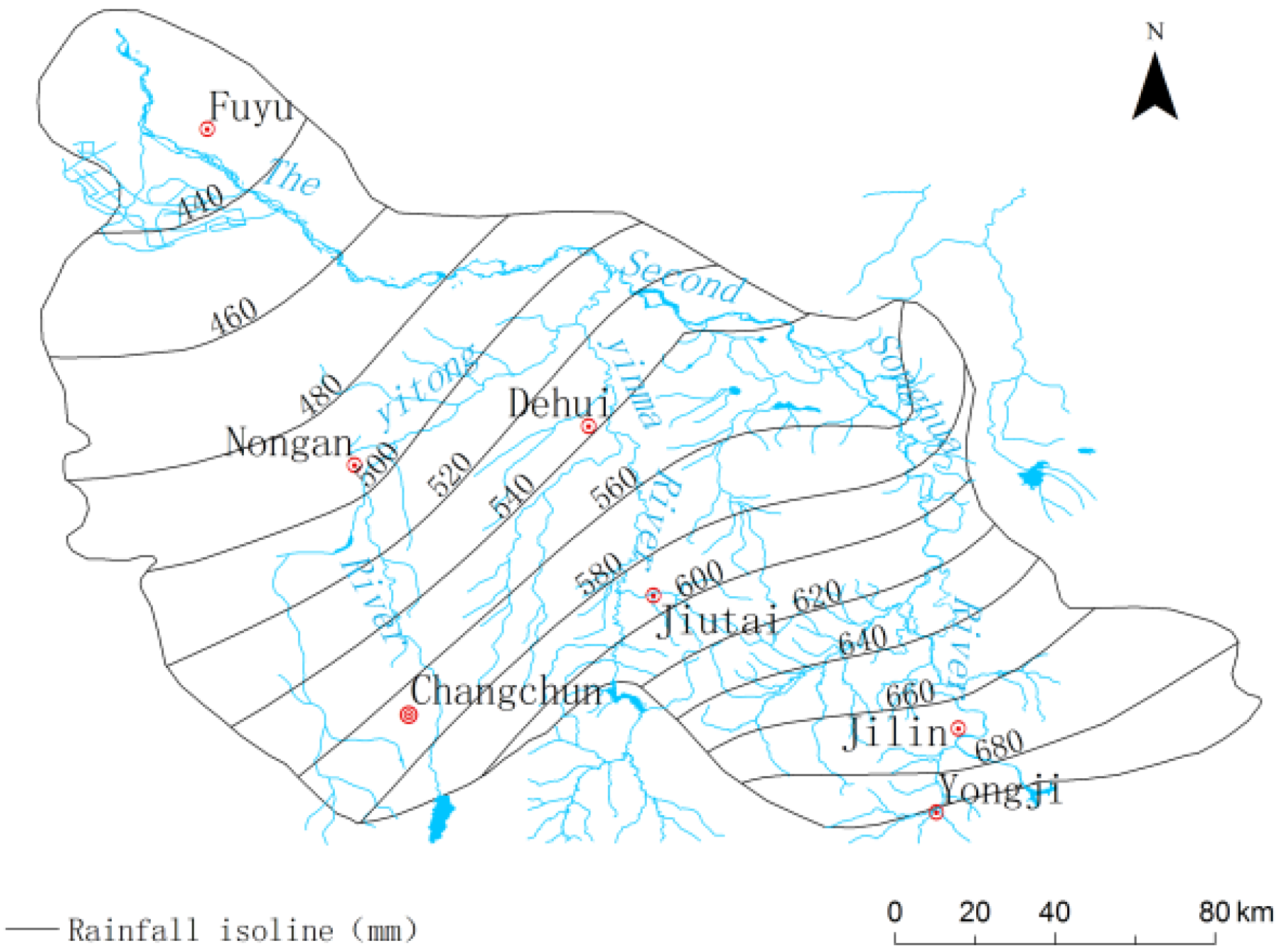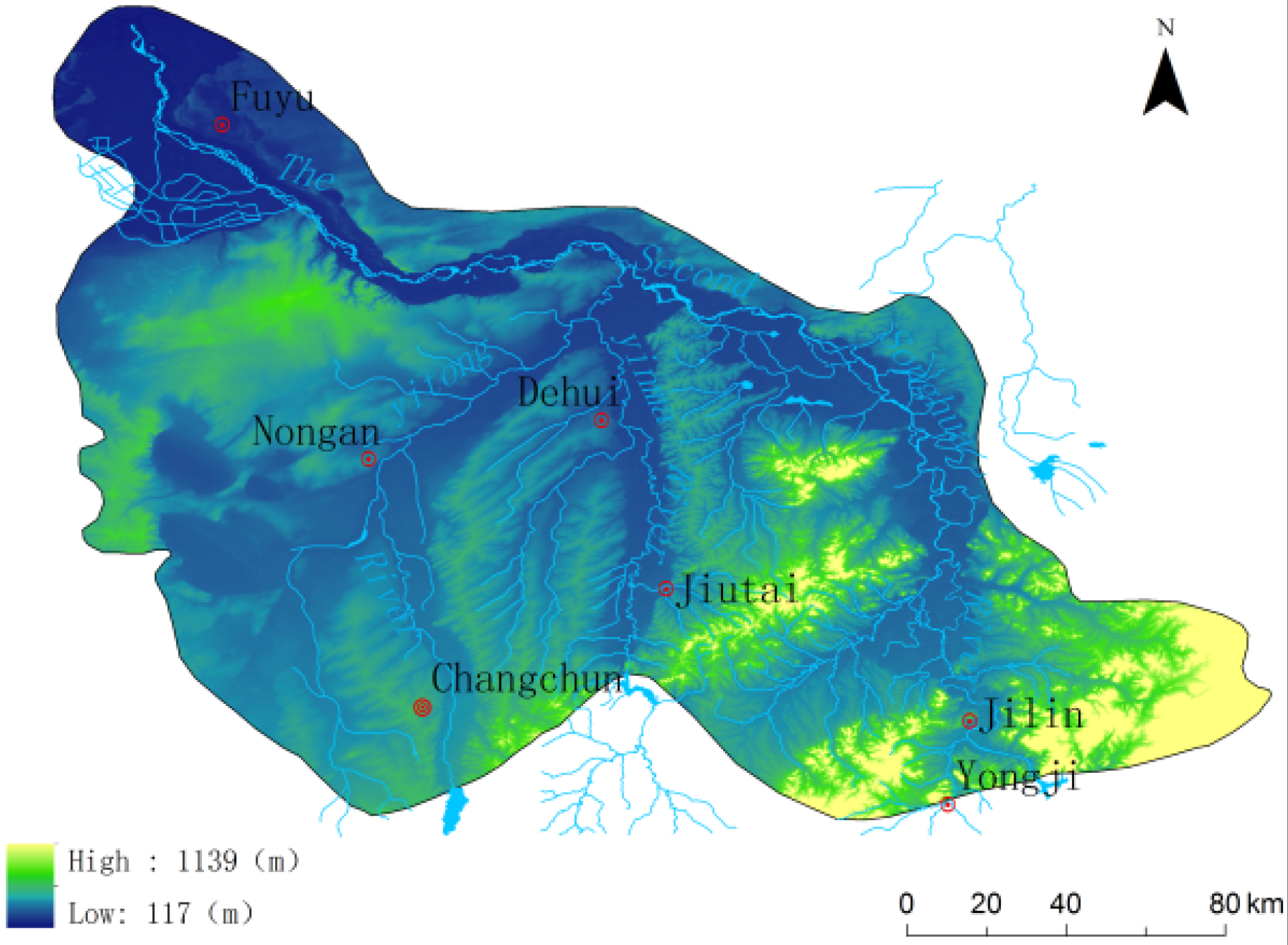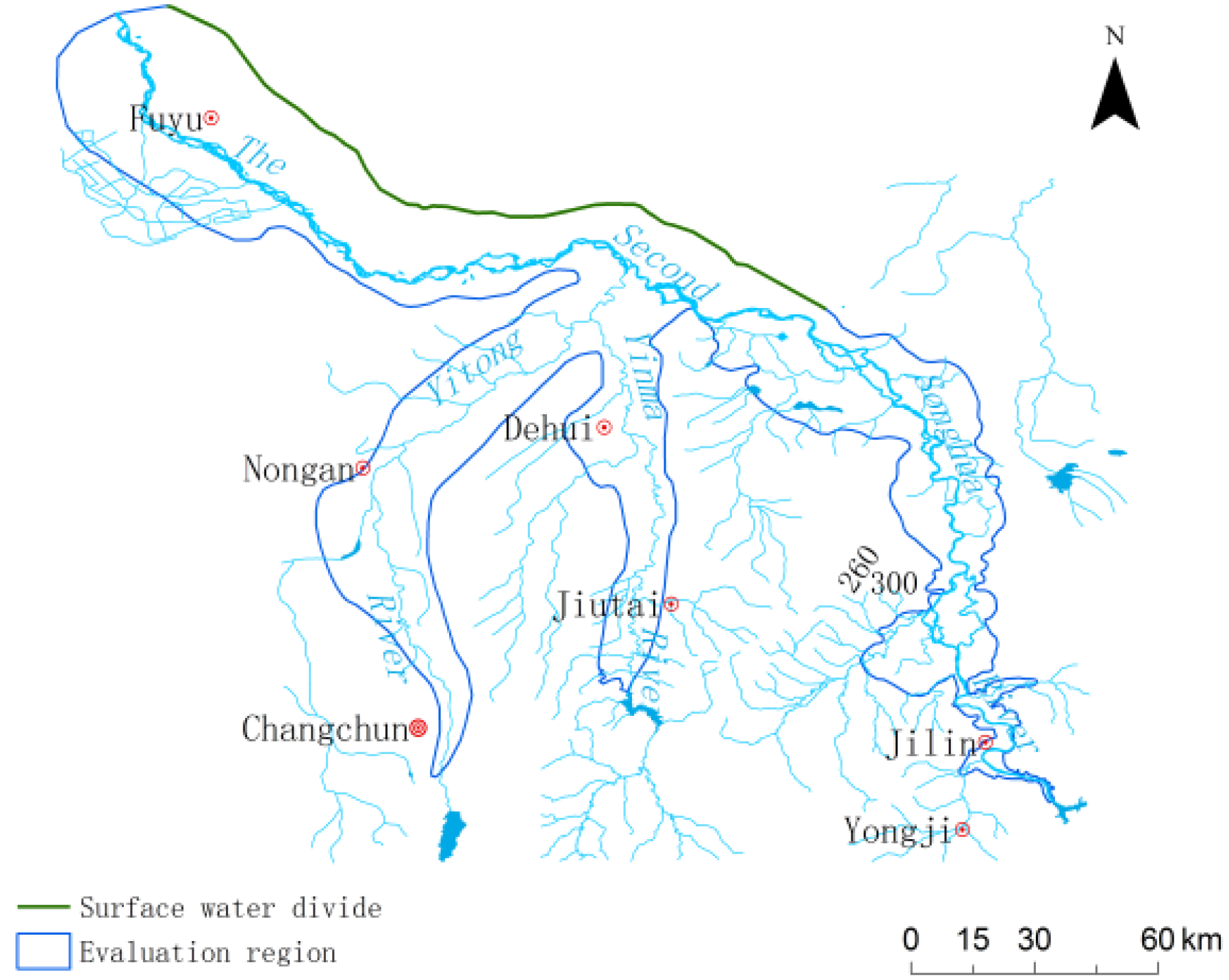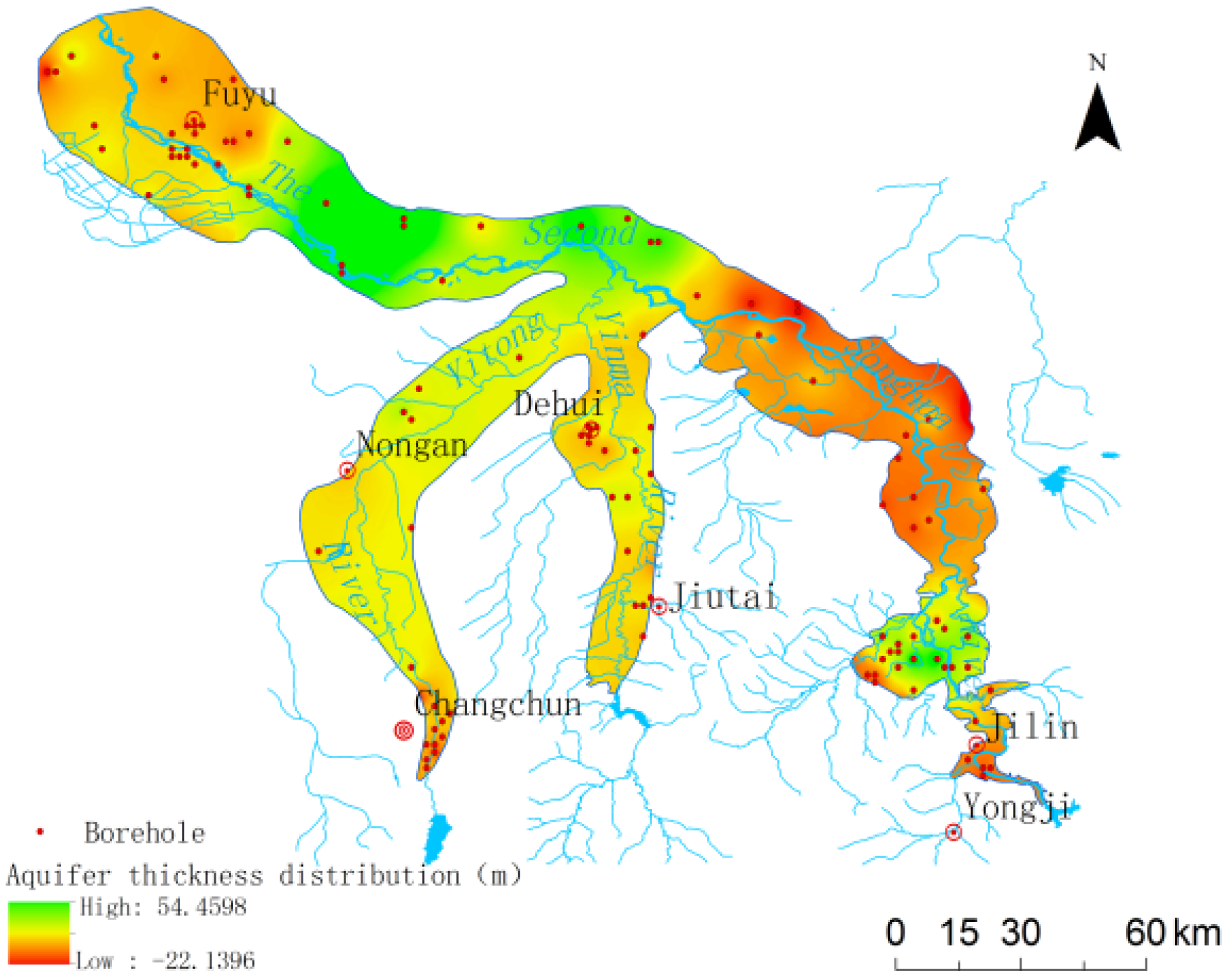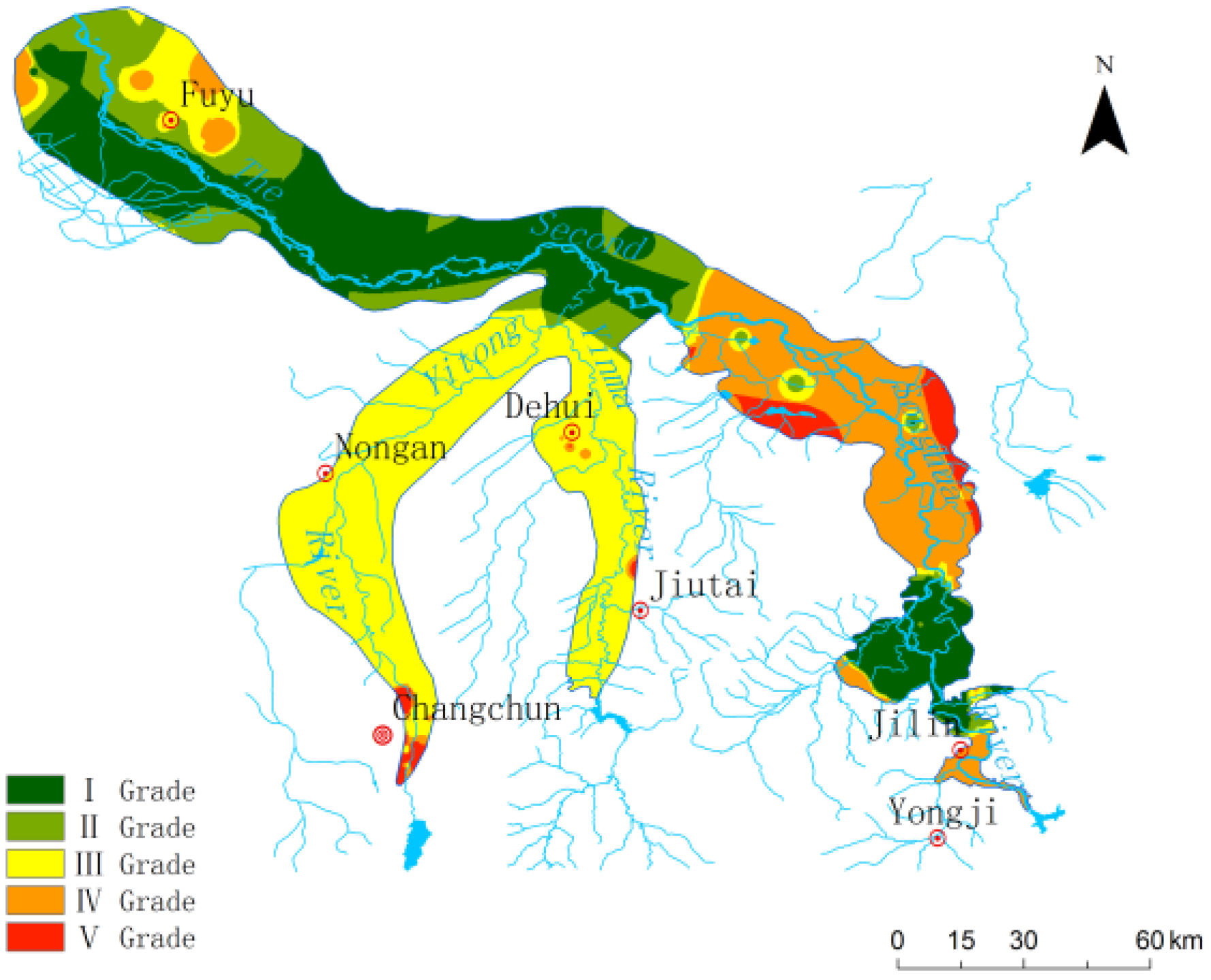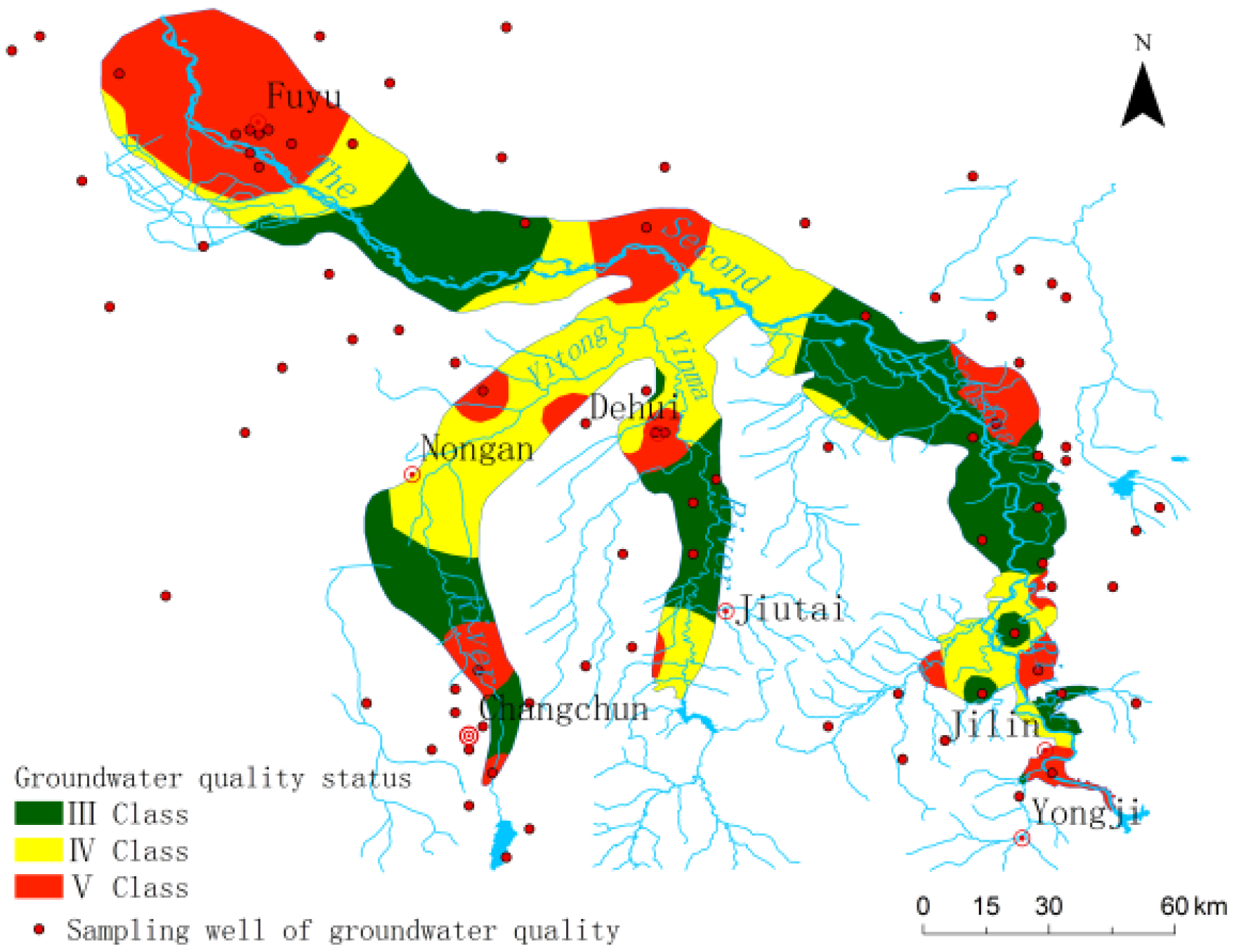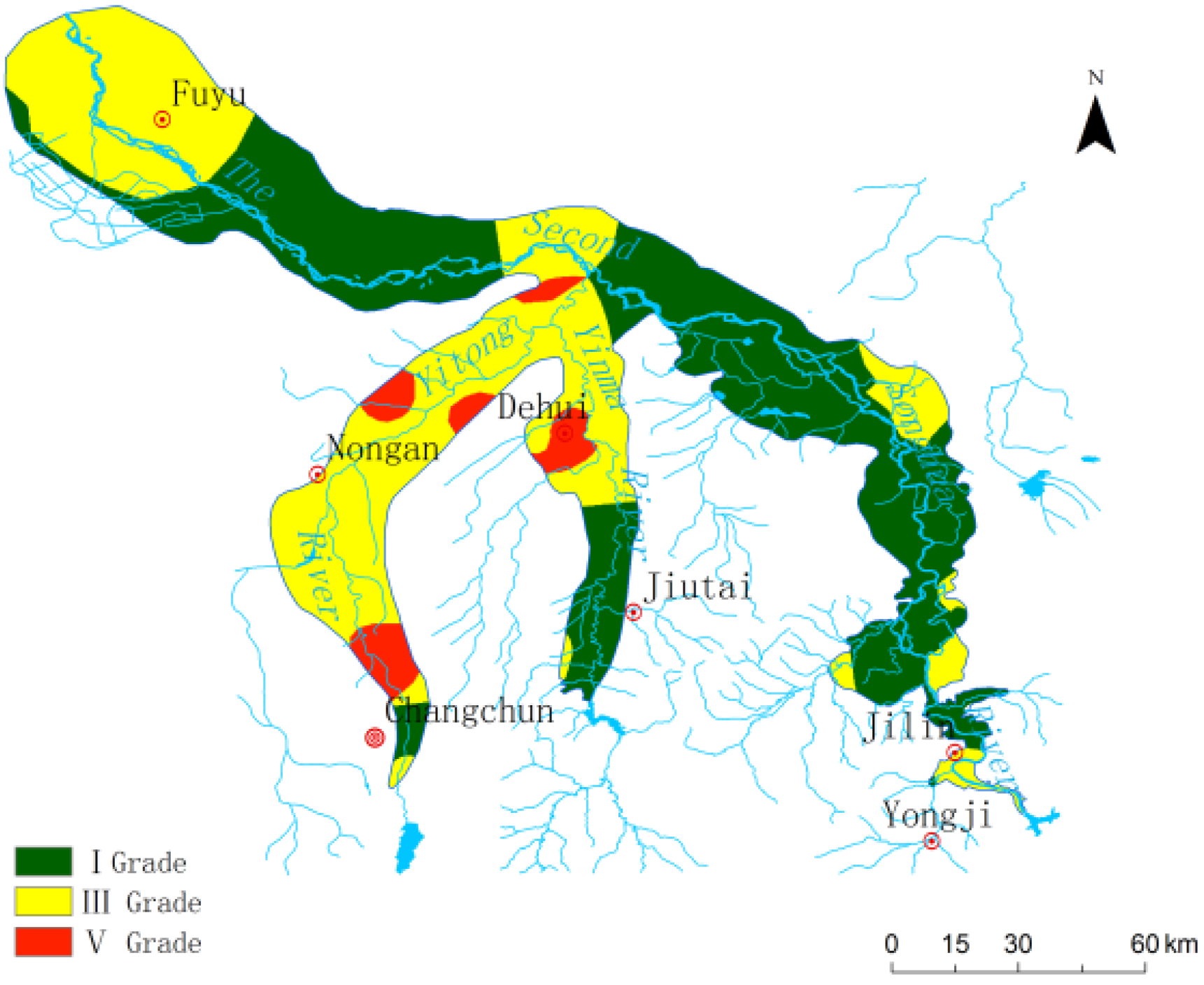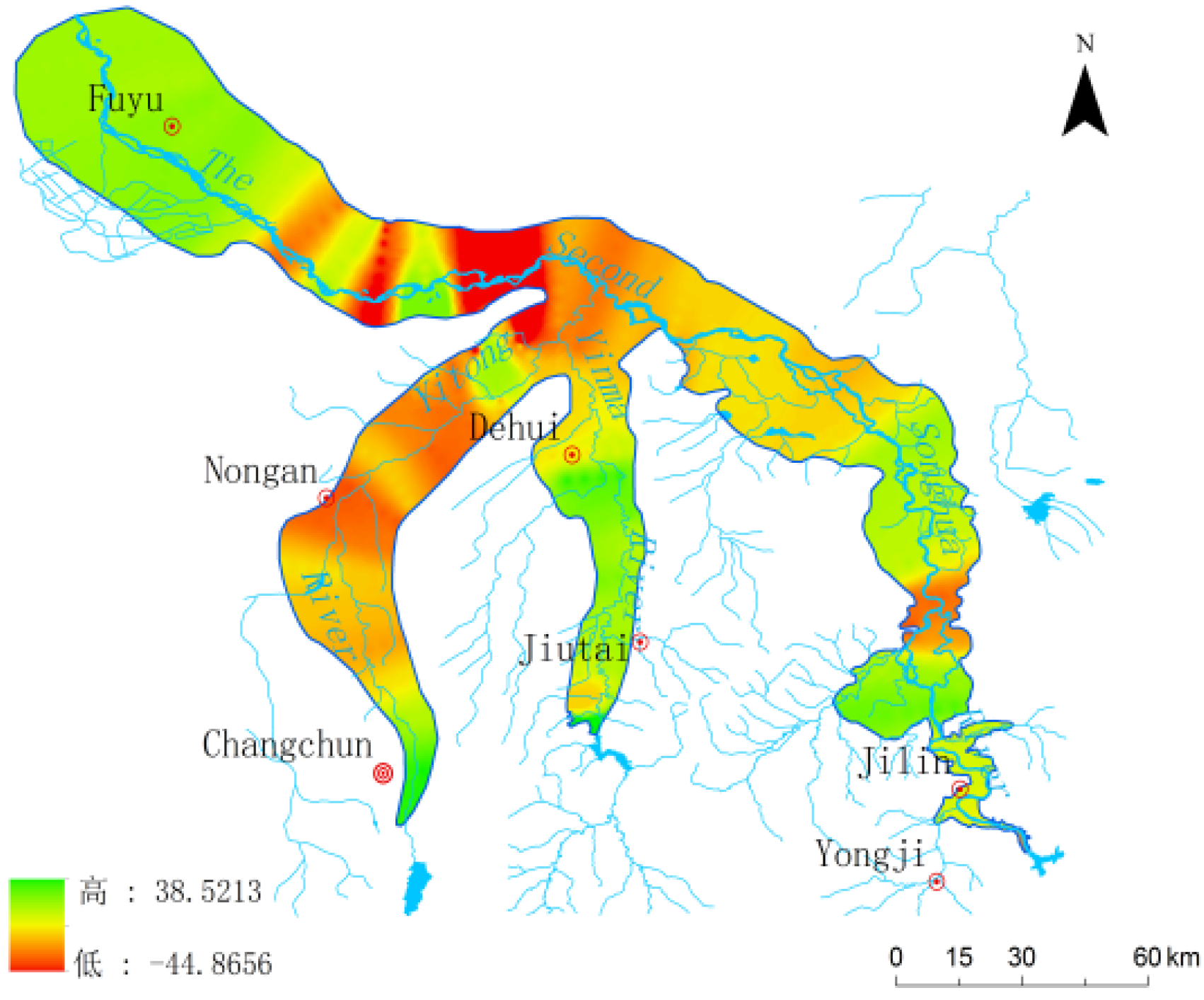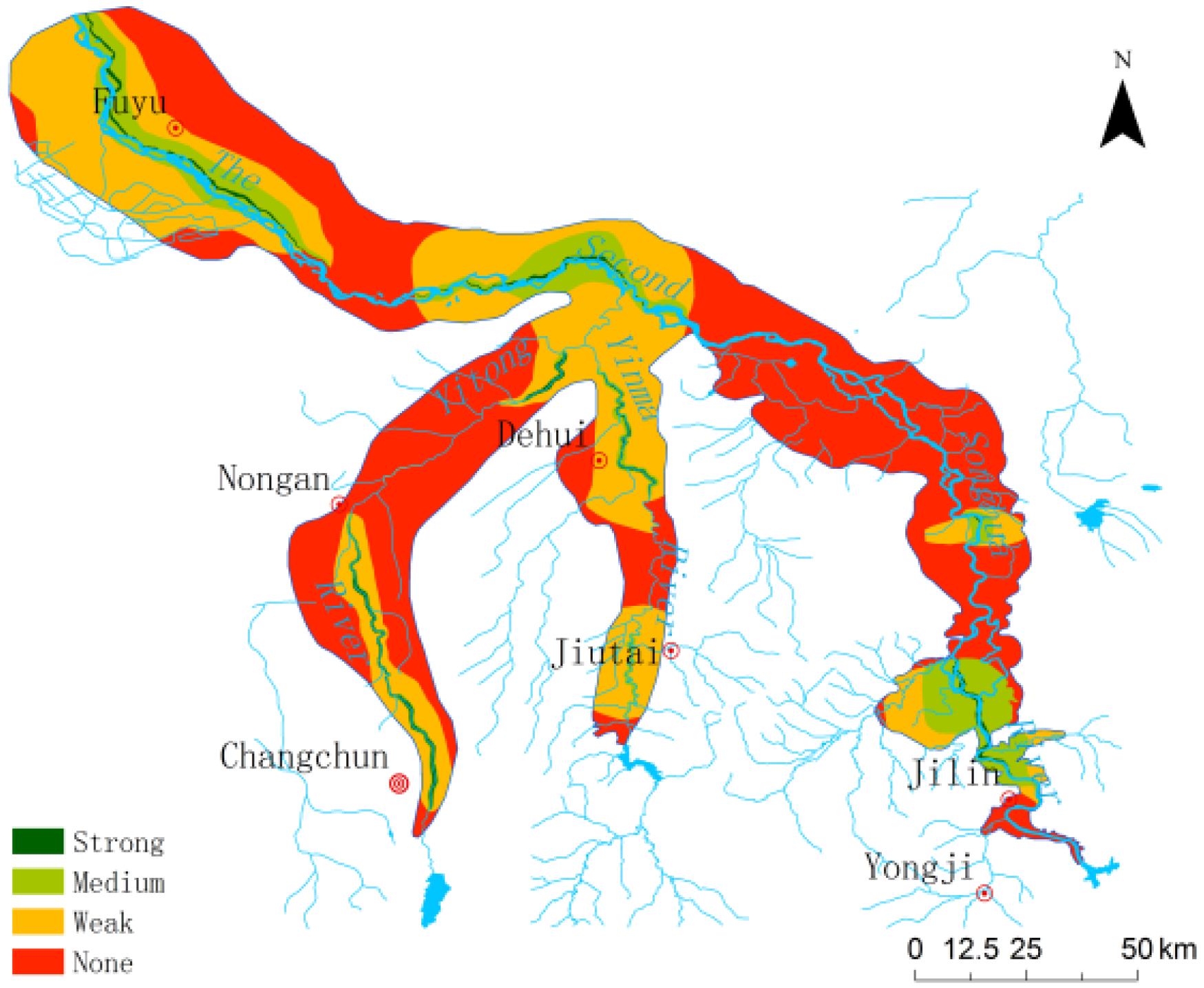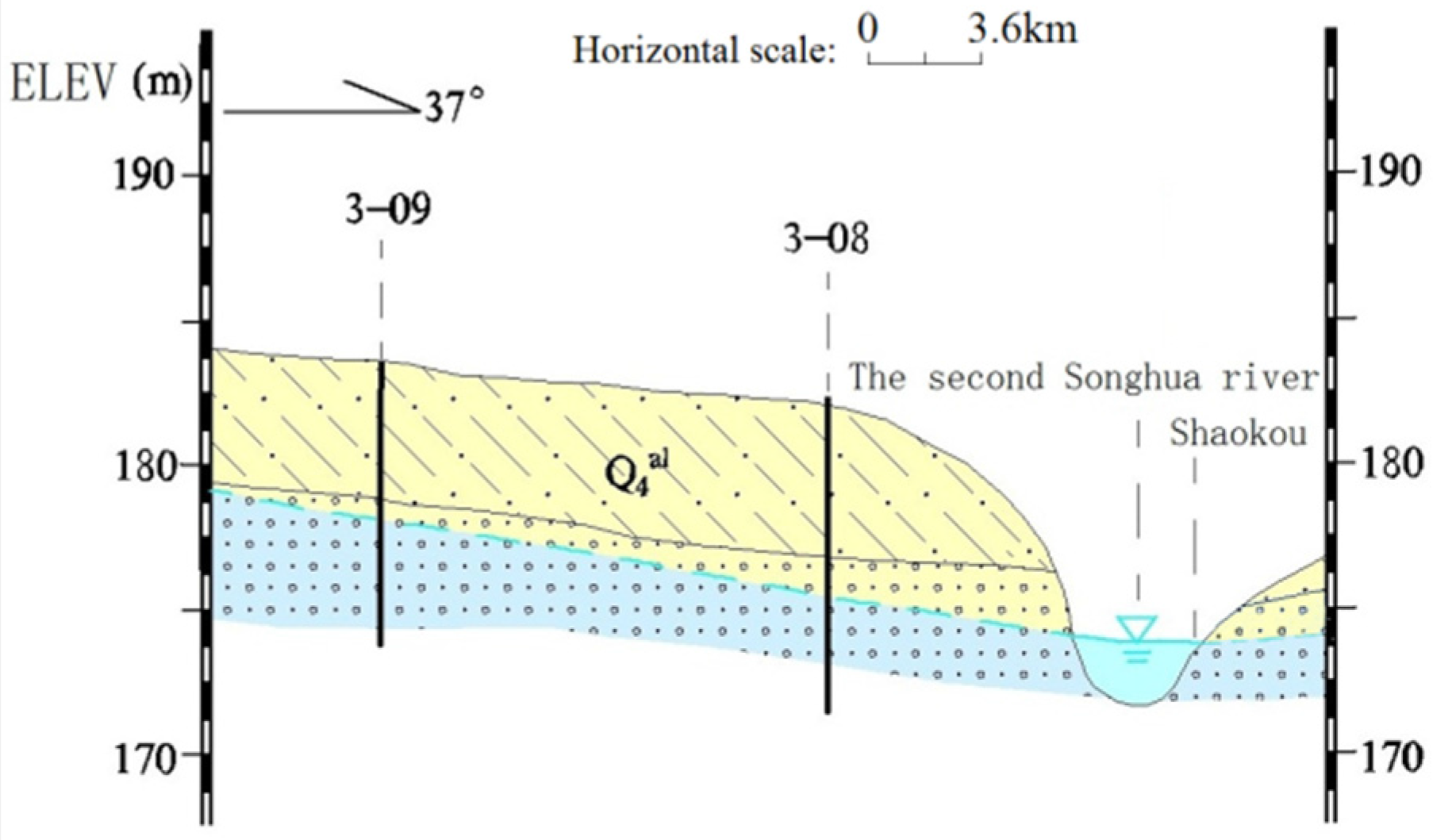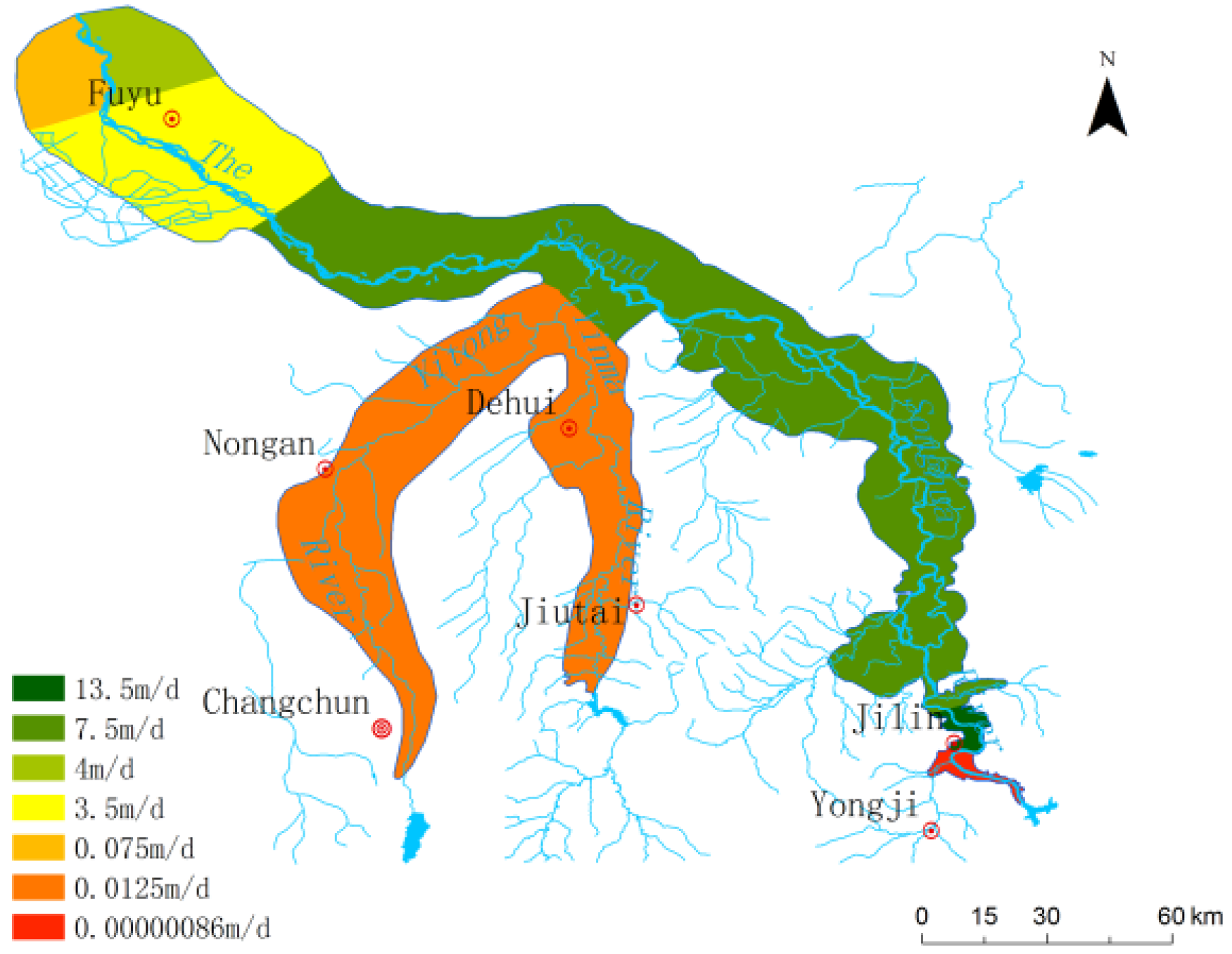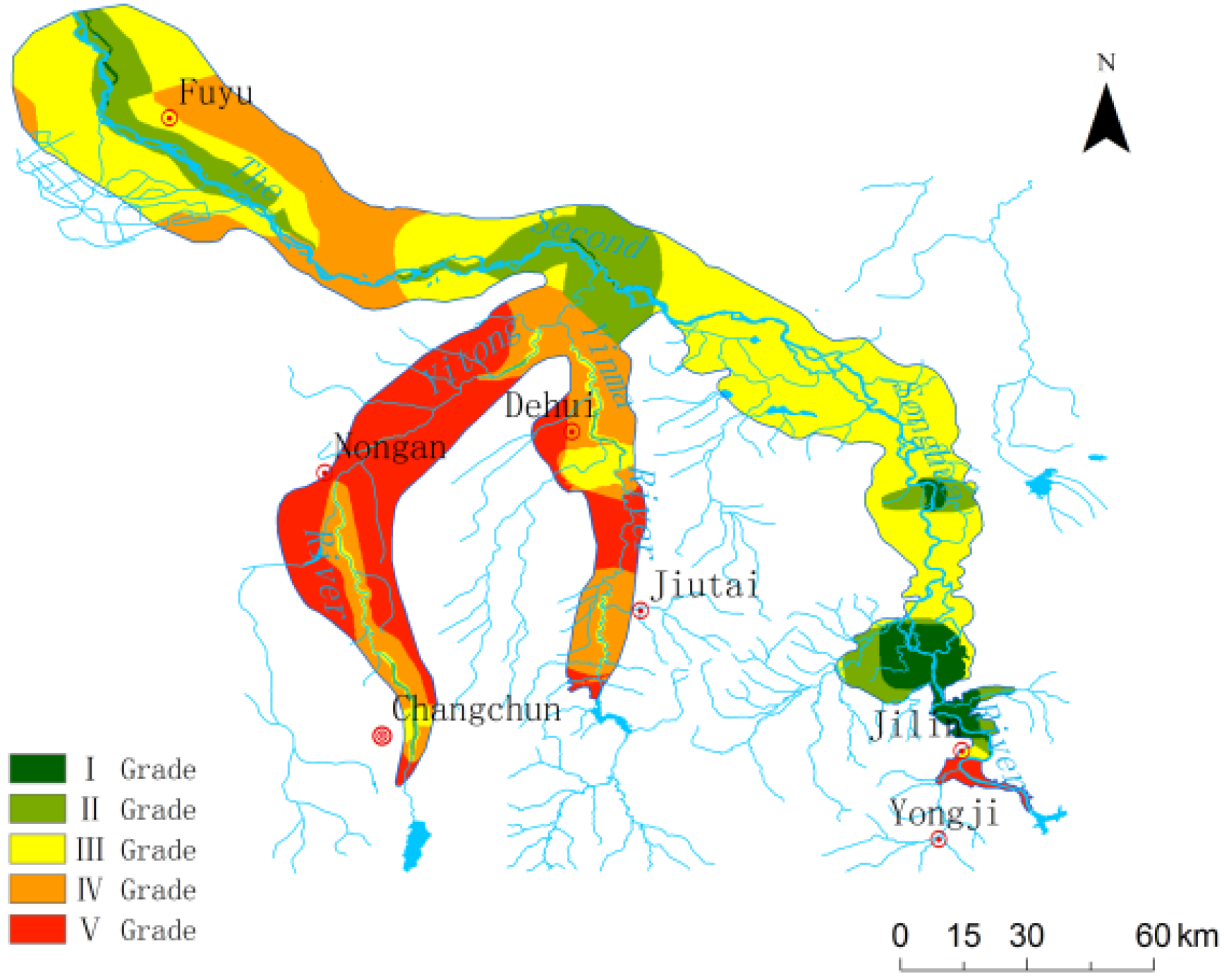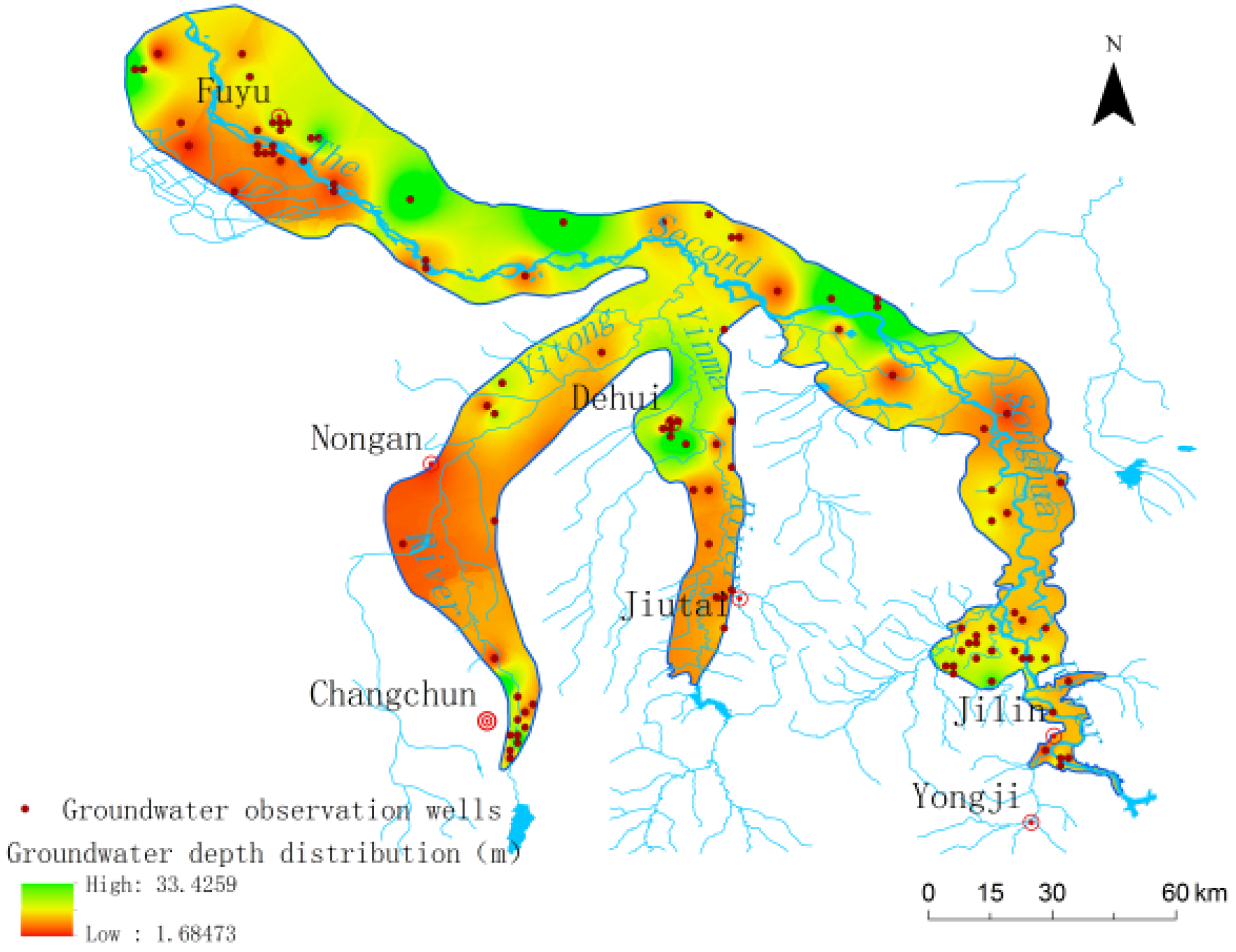1. Introduction
With its rich and stable water quantity, good water quality, and easy access and management, river bank filtration (RBF) is widely adopted in many countries and has become an important means of groundwater exploitation [
1,
2]. In Holland, Germany, Slovakia and Hungary, the proportion of total drinking water supplied by RBF water supply has reached 5%, 16%, 50% and 45%, respectively [
3]. The northern regions of China have established a number of RBF waterworks since the early 1950s; these include the Songhua River waterworks in Heilongjiang Province, the Hunhe River waterworks in Liaoning Province, the Jiuwutan and Beijiao waterworks in Henan Province, and the Hanzhong waterworks in Shanxi Province [
4]. To date, more than 300 large riverside RBF waterworks [
5,
6,
7,
8] have been established in China.
The combined use of surface water and groundwater resources can be realized through RBF, which can stimulate and increase the recharge of river water to the aquifer [
9]. However, the unreasonable exploitation of groundwater resources will lead to a continually descending groundwater level, the disruption of the hydraulic connection between groundwater and surface water, saltwater intrusion and land subsidence [
10]. From the perspective of the surface water infiltration process and runoff variation along the river, Qin (1995) proposed a vertical seepage method by combining Manning’s Formula and Darcy’s law to calculate the water recharge capacity of river water [
11]. The riverbed clogging issue was thought to be an important factor that affects the performance of the riverbank filtration system [
12]. Han (1996), according to the landform unit of different RBF waterworks, divided water sources into four types, including intermountain valley, intermountain basin, alluvial-proluvial fan and coastal plain [
4]; the researchers concluded that the infiltration capacity calculation of surface water is the key link during the water resources evaluation of RBF waterworks. Grischek and Ray (2009) presented the surface-groundwater interaction issues at various geomorphologic settings, from the headwaters of a river to its confluence with oceans/lakes [
13].
The quality of surface water can be improved by the physical, chemical and biological processes that take place in RBF process. As surface water infiltrates groundwater, the total organic carbon, turbidity, heavy metals, inorganic substances, viruses, parasites and some microorganisms in surface water can be effectively reduced. In RBF systems, 60% of the total organic carbon and 90% of the turbidity can be removed [
3,
14]. Likewise, 90% of chromium and arsenic, and 50% of cadmium, zinc, lead, copper and nickel can be removed [
15]. The removal of ammonia nitrogen can reach 95% [
16], and the removal of bacteria, parasites, and viruses can reach 100% [
14].
In the past, a large number of studies have been conducted mainly for specific RBF waterworks. Different methods were developed to analyze the feasibility of RBF systems [
17,
18,
19]. For the feasibility research of RBF sites in a regional setting, Sandhu
et al. (2011) provided the analysis results in India [
14]. So far, there are only few publications on the suitability evaluation of RBF on the scale of a river basin, because a generalization of site selection criteria is very difficult.
In this research, the downstream river basin of the Second Songhua River was set as the study area and the potential suitable area for RBF was evaluated. Based on the analysis of regional natural geography and hydrogeological conditions, an index system was established to evaluate the suitability of RBF along the main stem of the river in the study area.
2. Study Area
The Second Songhua River is the largest river in Jilin Province, and originates from Tianchi Lake in the Changbai Mountains. The catchment area is 7.3 × 10
4 km
2, including the tributaries of the Yitong River, Yinma River, Mangniu River and others, and accounts for 38.2% of the total province area. The study area focuses on the plain area of the Second Songhua River catchment with a total area of 2.46 × 10
4 km
2 (
Figure 1).
The major cities in the study area include Changchun City, the provincial capital of Jilin Province, and Jilin City, Dehui City, Jiutai City, Nong’an County, and Fuyu County. The total length of the Second Songhua River is approximately 330 km in the study area. The Yinma River is the largest tributary of the Second Songhua River and stems from Hulanling Mountain in Panshi County, Jilin Province, finally entering the Second Songhua River in Nong’an County. The Yitong River is the tributary of the Yinma River and the second tributary of the Second Songhua River. The Yitong River stems from the north of Qingding Mountain in Yitong County, Jilin Province, and finally flows into the Second Songhua River. The average annual precipitation in the study area is 400–700 mm, decreasing from southeast to northwest (
Figure 2). Both sides of the Second Songhua River are dominated by the valley plain geomorphic unit. The sedimentary plain is divided into multiple blocks between rivers with floodplain and terrace, and the surface elevation decreases gradually from the southeast to the northwest (
Figure 3). Quaternary sediment with good permeability is widely distributed in the Second Songhua River Basin with a thickness of 10–30 m. The type of groundwater is mainly pore groundwater in the sandy gravel layer and the groundwater table is shallow, generally 1–3 m below the ground surface. The single well groundwater production rate is generally 1000–3000 m
3/d. Surface water and groundwater are well connected, and groundwater recharges surface water in most areas along the river (
Figure 4).
Municipal and industrial wastewater seriously affects the water quality of Second Songhua River. Annual emissions of wastewater in this basin are about 645 million tons, of which 44% arises in Jilin Province. As total nitrogen, total phosphorus, ammonia nitrogen exceed the standard, water quality deterioration in the Yinma River is very serious; the river length in which water quality is inferior to Grade V water quality accounts for 42.9% of the total length [
20]. Changchun City is located in the middle reach of the Yitong River, and municipal and industrial sewage has had serious impacts on water quality of the river [
21]. The Second Songhua River in Jilin Province has abundant water resources, but now cannot meet the needs of economic development, especially the water requirement of large cities [
22].
5. Conclusions
Many important factors affect the site selection for RBF works such as groundwater and surface water quantity, current water quality situation, hydraulic interaction degree and exchange relationship between groundwater and surface water. In this research, a multi-criteria index system was developed for the regional assessment of RBF site suitability in the Second Songhua River and Yinma River. The system was based on a detailed analysis of physical geography and geological and hydrogeological conditions (which were considered to be the main influential factors of RBF), as well as on the development and utilization of water resources and water demand. Scoring criteria based on specialist marking methods were used to determine weighting coefficients and weighted scores. The evaluation method was integrated into the spatial analysis features of GIS to determine the distribution of suitable areas for RBF works. By identifying the suitability grade of areas along the Second Songhua River, the regional evaluation system highlights locations that should be targeted for RBF works. The suitability evaluation system developed in this research thus provides a scientific basis for making decisions for regional industry distribution and relevant groundwater development plans.
However, this research still has some limitations that must be mentioned here and will be studied further. (1) The evaluation index system to assess RBF site suitability that was established in this research is suitable for use only in the Second Songhua River catchment. Unfortunately, this catchment is not universally representative of other catchments because of its very specific hydrogeological conditions. (2) The index system is not very comprehensive; some factors such as riverbed thickness and river width were missing because of the limited field data in the study area.(3) Some index value such as riverbed permeability was inferred by limited information, and this would bring some uncertainty to the final results. (4) The specialist marking method was adopted to determine the preference weights; the applicability was limited within specific areas. The AHP (Analytic Hierarchy Process) method and Fuzzy theory would be better to adopt in a general index system [
27,
28]. (5) For the specialist marking method, it is important to perform a sensitivity analysis on the preference weights and provide measures for assessing the sensitivity due to changes in these weights [
28,
29]. Nevertheless, the primary evaluation principle and the index system are reasonable, and can be used as a scientific reference for any other regional site selection or feasibility research of RBF.
